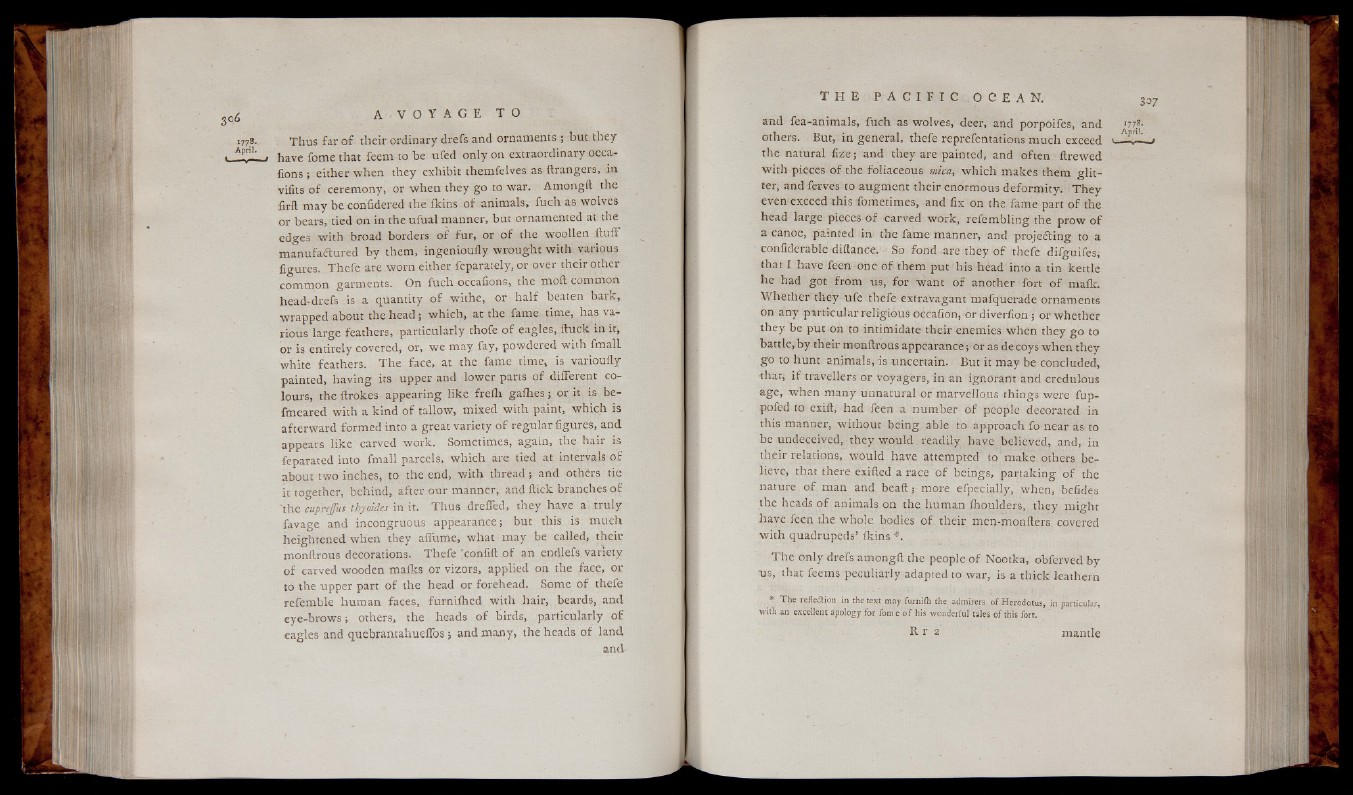
Thus far o f their ordinary drefs and ornaments ; but they
have fome that feem to be ufed only on extraordinary oeca-
fions ; either when they exhibit themfelves as ftrangers, in
vilits o f ceremony, or when they go to war. Amongft the
firit may be conildcred the fkins o f animals, fuch as wolves
or bears, tied on in the ufual manner, but ornamented at the
edges with broad borders o f fu r , or o f the woollen fluii
manufactured by them, ingenioufly w rou ght with various
figures. The fe are worn either feparately, or over their other
common garments. On fu ch occafions, the moil-common
he ad -d re fs'is a quantity o f withe, or h a lf beaten bark,
wrapped about the head ; which, at the fame time, has various
large feathers, particularly thofe o f eagles, ilu ck in it,
or is entirely covered, or, we may fay, powdered with fmall
white feathers. T he face, at the fame time, is varioully
painted, having its upper and lower parts o f different colours,
the itrokes appearing like fre lh gaihes ; or it is be-
fmeared with a kind o f tallow, mixed with paint, w hich is
afterward formed into a great variety o f regular figures, and
appears lik e carved work. Sometimes, again, the hair is
feparated into fmall parcels, w hich are tied at intervals o f
about two inches, to the end, with thread ; and others tie
it together, behind, after our manner, and flick branches o f
‘ the cuprejfus thyoides init. Thus drefied, they have a tru ly
favage and incongruous appearance ; but this is much
heightened when they allume, what may be called, their
monftrous decorations. Thefe 'confili o f an endlefs variety
o f carved wooden malks or vizors, applied on the face, or
to the upper part o f the head or forehead. Some o f thefe
refemble human faces, furnilhed w ith hair, beards, and
eye -b rows; others, the heads o f birds, particularly o f
eagles and quebrantahuelfos ; and many, the heads o f land
andand
fea-animals, fuch as wolves, deer, and porpoifes, and »77.8-
others. But, in general, thefe reprefentations much exceed - -
the natural fize ; and they are painted, and often ilrewed
with pieces o f the foliaceous mica, w h ich makes them g lit ter,
and ferves to augment their enormous deformity. They
even exceed this fometimes, and fix on the fame part o f the
head large pieces o f carved work, re femblin g the prow o f
a canoe, painted in the fame manner, and p ro je ilin g to a
confiderable diftance. So fond are they o f thefe difguifes,
that I have feen one o f them put his head into a tin kettle
he had got from us, for want o f another fort o f malic.
Whether they ufe thefe extravagant mafquerade ornaments
on any particular religious occafion, or diverfion’; or whether
th e y be put on to intimidate their enemies when they g o to
ba ttle ,by their monftrous appearance;-or as decoys w hen they
g o to hunt animals, is uncertain. But it may be concluded,
•that; i f travellers or voyagers, in an ignorant and credulous
age, when many unnatural or marvellous things were fup-
pofed to exift, had feen a number o f people decorated in
this manner, without being able to approach fo near as to
be undeceived, they would readily have believed, and, in
their relations, would have attempted to make others believe,
that there exifted a race o f beings, partaking o f the
nature o f man and b e a ft; more efpecially, when, befides
the heads o f animals on the human ihoulders, they might
have feen the whole bodies o f their men-monllers covered
with quadrupeds’ ikins *.
T h e only drefs amongft the people o f Nootka, obferved by
us, that feems peculiarly adapted to war, is a thick leathern
* T h e refleflion in the text may furniih the admirers o f Herodotus, in particular,
with an excellent apology for fome o f his wonderful tales o f this fort.
R r 3 mantle